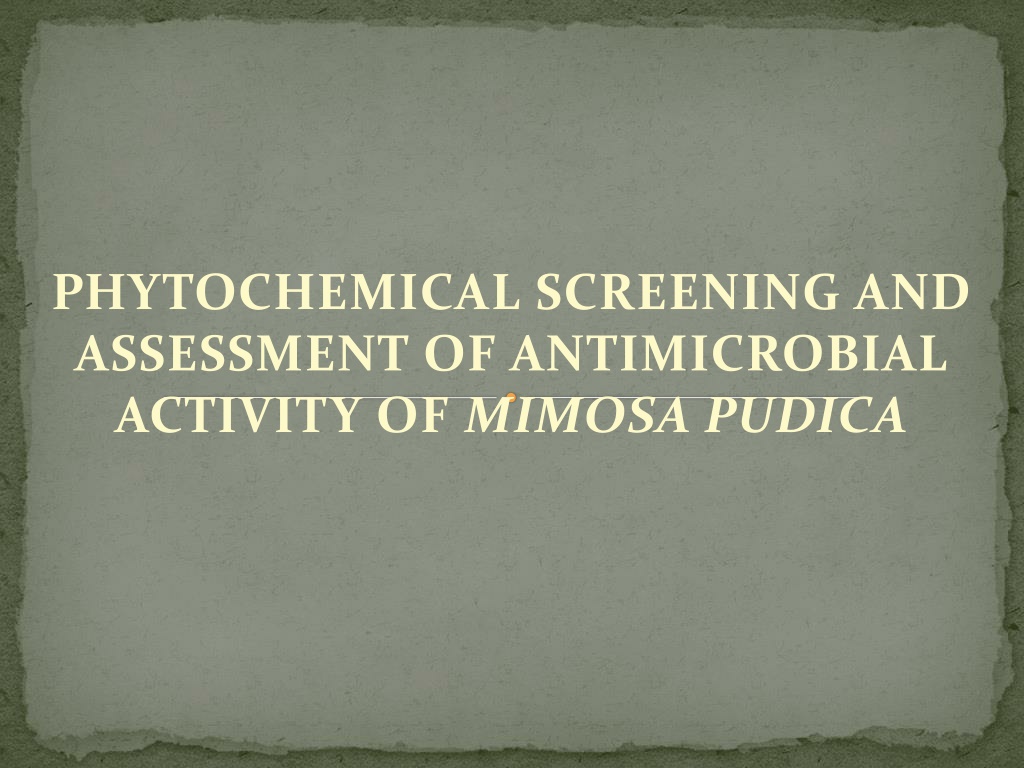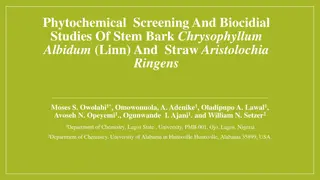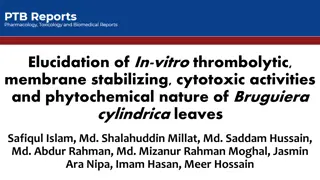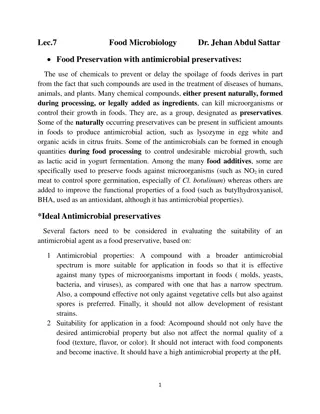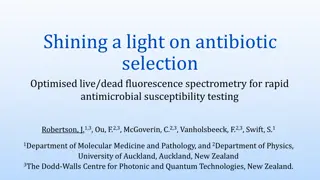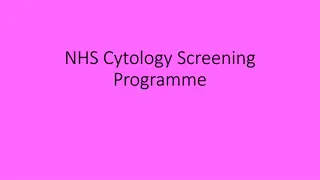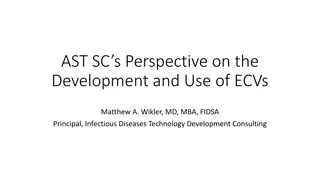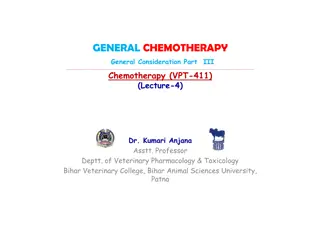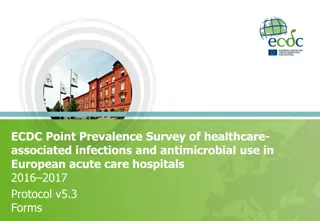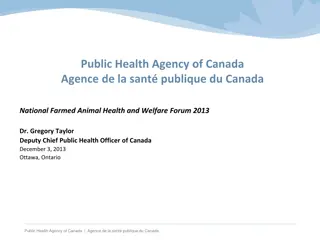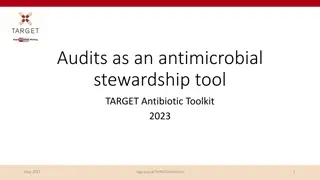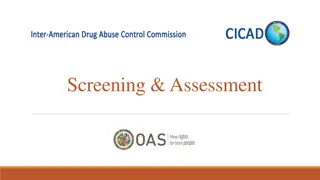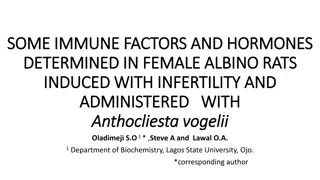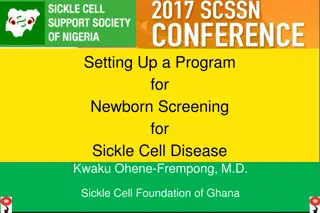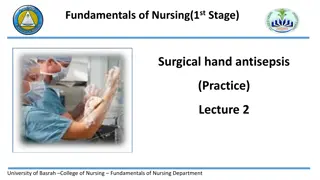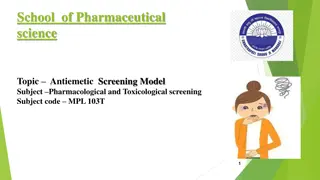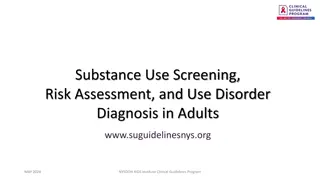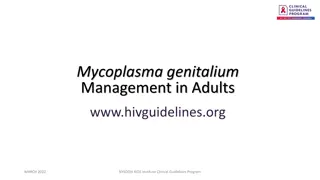Phytochemical Screening and Antimicrobial Assessment of Mimosa pudica
This study explores the antimicrobial potential of Mimosa pudica extracts through phytochemical screening. Researchers investigated the leaves' antimicrobial characteristics and screened for phytochemical compositions to understand their effects on various microorganisms. The methodology involved sample collection, processing, preparation of plant extracts, and testing against different clinical isolates using the agar well diffusion method. The study aimed to contribute valuable insights into natural remedies for infectious diseases.
Download Presentation

Please find below an Image/Link to download the presentation.
The content on the website is provided AS IS for your information and personal use only. It may not be sold, licensed, or shared on other websites without obtaining consent from the author. Download presentation by click this link. If you encounter any issues during the download, it is possible that the publisher has removed the file from their server.
E N D
Presentation Transcript
PHYTOCHEMICAL SCREENING AND ASSESSMENT OF ANTIMICROBIAL ACTIVITY OF MIMOSA PUDICA
AUTHORS Orhue Osayamen, Amengialue (Ph.D Candidate) Lecturer at Wellspring University, NIGERIA nuclearbrain2003@yahoo.com Efosa Faith, Oviasogie (Ph.D) Lecturer at University of Benin, NIGERIA efosaoviasogie@yahoo.co.uk May Naomi Oyairibhor, Omoigberale (Ph.D Candidate) Lecturer at Ambrose Alli University, NIGERIA may.oyas@yahoo.com Basil Osahon, Omoregie (M.Sc Candidate) University of Benin, NIGERIA emmark_online@yahoo.com Ruth Ebunoluwa, Bodunrinde (B.Sc) NIGERIA ebunoluwa_ruth@yahoo.com
INTRODUCTION antibiotics in the significant infections through their static and cidal effects (but not without limitations like side effect and microbial resistance), nature as it were, has been a source of medicinal agents for thousands of years. Herbal medicine is based on the premise that plants contain natural substances that can promote health and alleviate illness (Balakumar and Rajan, 2011). Contrary to synthetic drugs, antimicrobial substances of plant origin are not associated with many side effects and have an enormous therapeutic potential to heal many infectious diseases. Plant extracts of many higher plants have been reported to exhibit antibacterial, antifungal and insecticidal properties under laboratory study (Satish et. al., 2007; Okigbo and Ogbonnaya, 2006.). With its pharmacological activities, Mimosa pudica has been reported to contain alkaloid, glycoside, flavonoid and tannis. While synthetic successes has undoubtedly of recorded management diseases and
OBJECTIVE OF STUDY This study was aimed at investigating the antimicrobial characteristics of extracts of Mimosa pudica leaves, and to screen for its phytochemical compositions responsible for its antimicrobial activity.
METHODOLOGY Sample Collection and Processing: Fresh leaves of Mimosa pudica was harvested, sun dried and pulverized into coarse particles, and then stored in a clean sterile dry container. Test Microorganism: Clinical isolates used were Streptococcus pyogenes, Staphylococcus aureus, Bacillus subtilis, Escherichia coli, Klebsiella pneumonia, Pseudomonas aeruginosa, Candida albican, Penicillun notatum and Aspergillus niger. Standardisation Of The Test Organisms: Each test organisms were sub-cultured with nutrient broth and its turbidity compared with that of 0.5 Mac Farland to standardize each culture to 106cfu/ml. Preparation Of Plant Extracts: Aqueous, ethanol, and methanol extraction of Mimosa pudica leavewere made and concentrated to paste-like form using the steam bath at 600C. Reconstitution Of Extracts: Extracts were reconstituted using distilled water to obtain 100mg/ml, 50 mg/ml, 25 mg/ml, 12.5 mg/ml, and 6.25 mg/ml concentrations and stored at 4oC in sample bottles until required.
Antimicrobial Activity: Antimicrobial activity was performed to evaluate the antimicrobial properties of each extracts employing the agar well diffusion method as described by Ahmad and Beg, (2001). Minimum Inhibitory Concentration (MIC): The broth dilution method as earlier described by Bailey and Evelyn (1970) was employed in the determination of the minimum inhibitory concentration (MIC) of each extracts. Minimum Concentration (MBC and MFC) The bactericidal and fungicidal concentrations of the extracts were determined with the absence of growth of bacteria and fungi colonies on plates after incubation. Bactericidal/Fungicidal Phytochemical Analysis: Qualitative screening of the crude sample/extracts were carried out to determine the presence of the following steroids, tannins, glycosides, saponins and flavonoids. phytochemicals: alkaloid,
RESULTS Table 1: Antimicrobial Activity Of Plant Extracts At 100mg/ml Concentration
Table Extracts At 50mg/ml Concentration 2: Antimicrobial Activity Of Plant
Table Extracts At 25mg/ml Concentration 3: Antimicrobial Activity Of Plant
Table 4: Minimum Inhibitory Concentration Of Aqueous Extract In mg/ml
Table 5: Minimum Inhibitory Concentration Of Ethanol Extract In mg/ml
Table 6: Minimum Inhibitory Concentration Of Methanol Extract In mg/ml
Table 7: For Aqueous, Ethanol And Methanol extracts Minimum Bactericidal Concentration
Table 8: Minimum Fungicidal Concentration For Aqueous, Ethanol And Methanol Extracts
Table 9: Qualitative Phytochemical Composition Of Plant Extract
SUMMARY RESEARCH FINDINGS Results of this research findings: 1.Extract of Mimosa pudica is a promising medicinal plant source for the treatment of gram positive and gram negative bacterial infections revealed the following 2. Extract of Mimosa pudica as a medicinal plant source, has a better and more efficient use as antibacterial agent over being an antifungal agent. 3. Qualitative phytochemical screening of Mimosa pudica revealed its constituents to be alkaloids, flavonoid, glycosides, steroids, saponin and tannin. bioactive phytochemical 4. Methanol is a better and more efficient solvent extractor of the bioactive phytochemical constituents of Mimosa pudica.
CONCLUSION While it has been widely observed and accepted that the medicinal value of plants lies in the bioactive phytochemicals present in plants (Veermuthu et. al., 2006), this research study has brought to knowledge, the promising benefits of exploring Mimosa pudica for its antibacterial medicinal values. potentials and other
